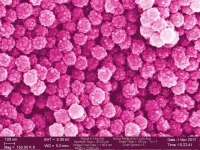(Press-News.org) DURHAM, N.C. - When patients complain of coughing, runny nose, sneezing and fever, doctors are often stumped because they have no fundamental tool to identify the source of the respiratory symptoms and guide appropriate treatments.
That tool might finally be on its way. In a study proving feasibility, researchers at Duke Health showed that their testing technology can accurately distinguish between a viral and a bacterial infection for respiratory illness - a critical difference that determines whether antibiotics are warranted. And, importantly, the test provided results in under an hour.
"This is exciting progress," said study lead Ephraim Tsalik, associate professor in the departments of Medicine and Molecular Genetics and Microbiology at Duke University School of Medicine.
"We've been working on this for over a decade," Tsalik said. "We knew in 2016 that our test worked in the research setting, but it's always been our goal to have a test that could produce results rapidly, while patients are at their doctor's office. It's important that the distinction can be made quickly to ensure that antibiotics are not inappropriately prescribed."
Tsalik and colleagues published results of their study in the journal Critical Care Medicine, which confirm the test's accuracy with results available in under an hour.
The researchers have developed a gene expression method that diverges from current diagnostic strategies, which focus on identifying specific pathogens. The current tests are time-consuming and can only identify a pathogen if it's specifically targeted by the test in the first place.
Host gene expression, however, looks for a distinct immune signal that is unique to the type of infection the body is fighting. The immune system activates one set of genes when fighting bacterial infections and a different set of genes in response to a viral infection. After the team discovered these gene expression signatures for bacterial and viral infection, they collaborated with BioFire Diagnostics, a company that specializes in molecular diagnostics, to develop this first-of-its kind test.
In a multisite study of more than 600 patients presenting to hospital emergency departments with respiratory infections, the tests identified bacterial infections with 80% accuracy and viral infections with nearly 87% accuracy. The current standard tests have about 69-percent accuracy. Tests provided results in less than an hour, and their accuracy was confirmed retrospectively using two different methods.
"Acute respiratory illness is the most common reason that people visit a health care provider when feeling sick," Tsalik said. "Patients with these symptoms are inappropriately treated with antibiotics far too often due to challenges in discriminating the cause of illness, fueling antibiotic resistance. Our study shows that a rapid test to distinguish between these two sources of illness is possible and could improve clinical care."
Tsalik said additional studies are underway to validate this approach in additional groups of patients. The researchers are also working to adapt the technology to produce more specific information, including whether the virus causing illness is influenza or SARS-CoV-2.
INFORMATION:
In addition to Tsalik, study authors include Ricardo Henao, Jesse L. Montgomery, Jeff W. Nawrocki, Mert Aydin, Emily C. Lydon, Emily R. Ko, Elizabeth Petzold, Bradly P. Nicholson, Charles B. Cairns, Seth W. Glickman, Eugenia Quackenbush, Stephen F. Kingsmore, Anja K. Jaehne, Emanuel P. Rivers, Raymond J. Langley, Vance G. Fowler, Micah T. McClain, Robert J. Crisp, Geoffrey S. Ginsburg, Thomas W. Burke, Andrew C. Hemmert, Christopher W. Woods and The Antibacterial Resistance Leadership Group.
The study received support in part from the National Institute of Allergy and Infectious Diseases of the National Institute of Health (U01AI066569, UM1AI104681) and the U.S. DARPA (N66001-09-C2082).
Among other conflicts listed in the study manuscript, Tsalik, Henao, McClain, Ginsburg, Burke and Woods have filed for patents pertaining to the gene signatures; Tsalik, Ginsburg and Woods are co-founders of Predigen, Inc., to develop the technology.
A new study published in Medical Care Research and Review found that the Affordable Care Act, which expanded Medicaid programs to cover people previously uninsured, provided a financial boost to hospitals.
The study conducted by faculty at the Colorado School of Public Health on the University of Colorado Anschutz Medical Campus is the first to investigate the effects of Medicaid expansion by comparing estimates using data from both the Internal Revenue Service (IRS) and the Centers for Medicare and Medicaid Services (CMS).
"The IRS and CMS data sources serve as primary resources for assessing the impact of Medicaid expansion on hospitals' financial status. The comparison of the two is timely and can inform ...
BOSTON - Researchers at Massachusetts General Hospital (MGH) have identified the protein "signature" of severe COVID-19, which they describe in a new study published in Cell Reports Medicine. "We were interested in asking whether we could identify mechanisms that might be contributing to death in COVID-19," says MGH infectious disease expert Marcia Goldberg, MD, who studies interactions between microbial pathogens and their hosts, and is senior author of the study. "In other words, why do some patients die from this disease, while others--who appear to be just as ill--survive?"
In March 2020, when the first patients with symptoms of COVID-19 ...
Wherever scientists look, they can spot them: whether in remote mountain lakes, in Arctic sea ice, in the deep-ocean floor or in air samples, even in edible fish - thousands upon thousands of microscopic plastic particles in the micro to millimeter range. This microplastic is now even considered one of the defining features of the Anthropocene, the age of the Earth shaped by modern humans.
Microplastics are formed by weathering and physicochemical or biological degradation processes from macroscopic plastic products, such as the tons of plastic waste in the oceans. It is unlikely that these degradation processes will stop at the micrometer ...
On September 28, 2018, an inexplicably large tsunami devastated the Indonesian coastal city of Palu and several others nearby. Between the tsunami and the magnitude 7.5 earthquake that caused it, some 4,340 people were killed, making it the deadliest earthquake that year.
The tsunami's waves reached around six meters high, which was a shock to geophysicists who had believed that earthquakes along a strike-slip fault could only trigger far smaller tsunamis for that particular region. Now, new research describes a mechanism for these large tsunamis to form, and suggests that other coastal cities that were thought to be safe from massive tsunamis may need to reevaluate their level of ...
Daegu Gyeongbuk Institute of Science and Technology (DGIST) scientists in Korea have developed algorithms that more efficiently measure how difficult it would be for an attacker to guess secret keys for cryptographic systems. The approach they used was described in the journal IEEE Transactions on Information Forensics and Security and could reduce the computational complexity needed to validate encryption security.
"Random numbers are essential for generating cryptographic information," explains DGIST computer scientist Yongjune Kim, who co-authored the study with Cyril Guyot and Young-Sik Kim. "This randomness is crucial for the security of cryptographic systems."
Cryptography is ...
University of South Australia researchers have identified an enzyme that may help to curb chronic kidney disease, which affects approximately 700 million people worldwide.
This enzyme, NEDD4-2, is critical for kidney health, says UniSA Centre for Cancer Biology scientist Dr Jantina Manning in a new paper published this month in Cell Death & Disease.
The early career researcher and her colleagues, including 2020 SA Scientist of the Year Professor Sharad Kumar, have shown in an animal study the correlation between a high salt diet, low levels of NEDD4-2 and advanced kidney disease.
While a high salt diet can exacerbate some forms of kidney disease, until now, researchers did not realise ...
Pioneering neural recordings in patients with Parkinson's disease by UC San Francisco scientists lays the groundwork for personalized brain stimulation to treat Parkinson's and other neurological disorders.
In a study published May 3rd in Nature Biotechnology, UCSF Weill Institute for Neurosciences researchers implanted novel neurostimulation devices that monitor brain activity for many months, with and without deep brain stimulation (DBS) therapy. Pairing the brain recordings with wearable monitors of movement, they identified patterns of brain activity corresponding to specific movement abnormalities associated with Parkinson's. Their research provides the first ...
HOUSTON - Researchers have found the right formula for mixing a cement that does double duty as a structural material and a passive photocatalytic water purifier with a built-in means of replenishment: simply sand down the material's surface to refresh the photocatalytic quality.
They found this recipe using a few very precise physical laboratory experiments whose data were then greatly amplified using a computational method called combinatorics that tested thousands of combinations of cement composites and their photocatalytic qualities.
The results, say the researchers from C-Crete Technologies and Rice University, indicate ...
Blood may seem like a simple fluid, but its chemistry is complex. When too much potassium, for instance, accumulates in the bloodstream, patients may experience deadly irregular heart rhythms.
Cardiovascular scientists at Virginia Tech's Fralin Biomedical Research Institute at VTC are studying why.
In a new study, published in Pflügers Archiv European Journal of Physiology, the research team led by Steven Poelzing, associate professor at the institute, describes how subtle changes in potassium, calcium, and sodium levels regulate heartbeats.
Poelzing ...
DALLAS (May 3, 2021) - Researchers from the Center for BrainHealth® at The University of Texas at Dallas are investigating a potential new early indicator of the decline toward Alzheimer's disease: measuring the energy metabolism of the living human brain using cutting-edge imaging techniques.
The scientists devised a unique way to illustrate energy consumption and reserves in the brain with phosphorus magnetic resonance spectroscopy using an ultra-high-field 7 Tesla MRI scanner. Their results suggest that neurological energy metabolism might be compromised in mild cognitive impairment (MCI), the stage of decline between healthy ...



